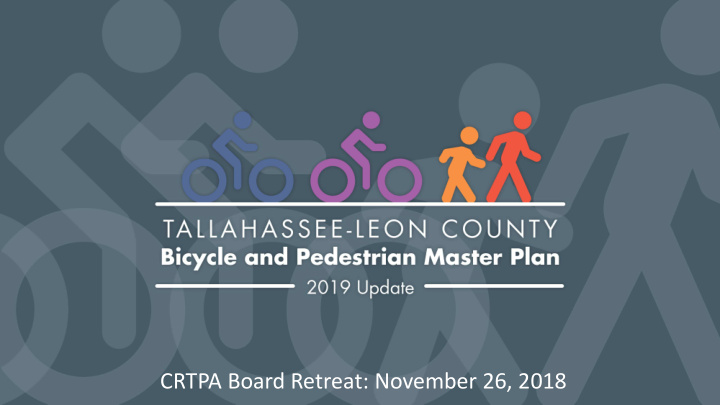



CRTPA Board Retreat: November 26, 2018
Projec ect Go Goals Improve safety for pedestrians and cyclists Make walking and biking predictable and more convenient in Tallahassee and Leon County
Project B Backgr ground • Project Kickoff in March 2018 • Project Team consists of staff from: • CRTPA • Blueprint • TLC Planning Department • Data Collection – ongoing • Stakeholder Meetings – completed • Focus Area Workshops – ongoing
Project A Approach • Previous Master Plan focused on implementing facilities on every road, everywhere • Focus areas with localized trips • Current approach is to develop recommendations based on: • Bicycle Comfort Level • Urban Bikeway Network • Public Input • Fulfillment of evaluation criteria • Sidewalks – fill gaps and improve crossings
Bi Bicycle Co Comfort Level • Data driven analysis: Traffic Volumes Number of Lanes Speed Existing Bicycle Facilities • Relate the results of this analysis back to the types of cyclists who would ride on each road based on existing conditions • Mapped roadway grade in relation to Bicycle Comfort Level to determine “ideal” roadways
Types o of Cy Cycl clists 3. Enthused and Confident 1. Children/Elderly Cyclists who feel comfortable Needs a facility completely riding along a corridor next to separated from the roadway such as vehicles at lower speeds and a multiuse trail. with facilities such as a bike lane or signage. 2. Interested but Concerned 4. Strong and Fearless Cyclists who would like to ride their Cyclists who will ride along a corridor bike but have fears which are regardless of the conditions. These usually caused by vehicles. This type users have no problem sharing the of cyclist needs low speeds, low lane with a vehicle traveling at volumes, and a separated facility speeds greater than 40 mph. such as a buffered bike lane.
BCL 4 BCL 3 BCL 2 BCL 1
Urban Bi Bikeway N Network rk • Residential streets with low traffic volumes and low speeds so the priority mode can be given to bicycles and pedestrians • These streets make ideal connections between more defined on-street facilities and multi-use paths • Urban Bikeway Network may include: Source: Seattle Neighborhood Greenway, Greenway Phinney • Uniform signage • Traffic calming • On-street markings • Branding Opportunities Source: BikePortland.org
Community O Outreach • Stakeholder Meetings • Joint City/County Bicycling Workgroup • Meetings with avid cyclists around the community • Universities • City and County Staff • StarMetro • FDEP Office of Greenways and Trails
Focus A s Area ea Worksh shops s • Public Workshops: Market Square and Northeast Neighborhoods FAMU, Southwest Area Neighborhoods TCC, FSU, and Downtown Tallahassee Midtown and Central Area Neighborhoods • Apalachee Parkway Neighborhoods • Scheduled for November 27 th
Focus A s Area ea Worksh shops s • Existing conditions for pedestrian and bicycling facilities • Minimum tolerance exercise • Majority of participants have identified themselves as “ interested but concerned ” when it comes to bicycling • Ideal routes mapping • Showing us where people ride, where they want to ride, and where pedestrian crossings are desired • Review of project goals and evaluation criteria
Focus A s Area ea Worksh shops s
Recommen endation Evaluation C Criter eria Saf afety y – Focus on infrastructure improvements in known crash areas Co Comfort rt – Reduce motorist conflict and promote shaded, easy to ride routes Connec ecti tivity – Connect users with destinations in and around the City Health Hea th – Promote healthier lifestyles through improved facilities and increased use Multimod modal – Develop usable routes for pedestrians, cyclists, and transit riders while not limiting motorists Equity ty – Improve transportation options for disadvantaged populations and in underserved areas Within M Multimodal Transportation D Distr trict ( (MMTD) ) – Prioritize the development of pedestrian, cyclist, and transit facilities within the MMTD
Asses sessm smen ent o of P Poten ential R Rout utes s MICCOSUKEE ROAD GEORGIA STREET • 32 ft • 28.9 ft • On-street parking • On-street parking • Bicycle Comfort Level 2 • Bicycle Comfort Level 3 • Posted Speed Limit – 30 mph • Posted Speed Limit – 30 mph
Next xt S Steps • Summarize Focus Area input • Evaluation of ideal routes • North/South connections • East/West connections • Community connections • Public Open House – February 2019 • Development of Draft and Final Master Plan Thank ank you! u!
Recommend
More recommend